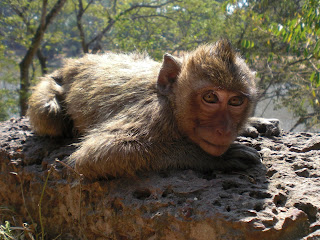
From a distance this looks like an old school that is no longer in use, which it is. The buildings are crumbling and the paint is fading, but blooming rhododendron trees frame a quiet courtyard. From a distance it appears tranquil.
But it is a bleak, terrible place. The air is thick with despair. Closer inspection reveals barbed wire fencing enclosing the walkways.

And 14 graves in the courtyard.

In April 1975 the Khmer Rouge took over Phnom Penh and emptied the city. The entire population was driven into the countryside where they were to become farmers. In less than four years about a quarter of the population was dead, mostly due to starvation. Hundreds of thousands died in combat. Tens of thousands were executed.
The KR also closed all the schools. Tuol Sleng, or S-21 as it was called during that dark era, was turned into a prison. Twenty thousand people came through. Only seven survived. The rest were killed here or taken to the Killing Fields.
Visting the Killing Fields was a sobering experience. But it was easy compared to Tuol Sleng. I was there for less than two hours but I was emotionally exhausted when I left. The Killing Fields and S-21 are similar in that they appear so ordinary.
But once inside the S-21 the horror smacks you in the face like the wall of cold air you feel walking into an icebox. The only thing I can compare it to is The United States Holocaust Memorial Museum in Washington.
The two places are completely different in that Tuol Sleng is the actual facility, in more or less the state it was found after the KR was kicked out of the country by the Vietnamese in 1979.
There were 14 prisoners at the facility when the KR evacuated it. But the KR wasn't about to pass up a chance to murder a few more innocent people. Those last prisoners were shot to death as they lay chained in their beds.
Photos of those poor souls are on the walls of the rooms in which they were discovered. They are gruesome and extremely hard to look at.

You have been warned...

All available evidence indicates that torture is useless as an interrogation tool. (People will say literally anything to escape physical pain.) But even if you believe torture has its uses, either as a means of gaining information or as a political tool to maintain control of a population, what is ultimately the most disturbing aspect, it seems to me, is how easy it is to find people to do it with such enthusiasm.
Before I visited the site I thought there was a joke somewhere about how going to high school felt a lot like torture. This rather sinister-looking sign is to remind visitors to respect the dead, but the atmosphere is so oppressive it's hard to imagine anyone wanting to smile or laugh here.

I couldn't help but flash to the debate -- and the insanity that the topic was even open to debate -- of whether the United States should torture detainees in Bush's war.
Anyone who thinks that torture is acceptable should be dragged kicking and screaming to S-21 and forced to look at the grimy, stained floors of the cells where the KR tortured thousands of innocent people.
The KR kept mind-numbingly meticulous records, in which they recorded the "confessions" of prisoners and obsessively cross-referenced them.
They also kept photographs of all prisoners. Surely there were those who opposed them and, by their rationale, deserved to be tortured. I doubt this guy was an active conspirator.

Photographs of all the S-21 prisoners are on display on dual-sided bulletin boards. This is one side of one of the bulletin boards. All of the prisoners are children!

In some of the photographs the subjects are smiling. I could only guess that these were the first prisoners, who had no idea what they were in for. In other photos, which I assume to have been taken later, the subjects are clearly aware of the horror they are about to endure.
I simply couldn't find a good angle to get a good shot of this man's photo, but even in this poor attempt the look on his face is haunting.

In an alternate universe this child would have been a beauty pageant contestant. Instead she was tortured, executed and dumped in a mass grave.

And yet some of the victims' faces burn with a fierce pride that I found oddly inspirational, considering the circumstances.

When I look back on this trip I will remember the joy of walking on the Great Wall, the awe I felt standing at the foot of Everest and the perfect, ghostly silence of the Sahara Desert at night. But, more importantly, I will always remember the sickening knot in my stomach when I left Tuol Sleng.
This has been the hardest post for me to write. The subject matter is disturbing, but I was also concerned about getting it right, out of respect for those who suffered at S-21.











































